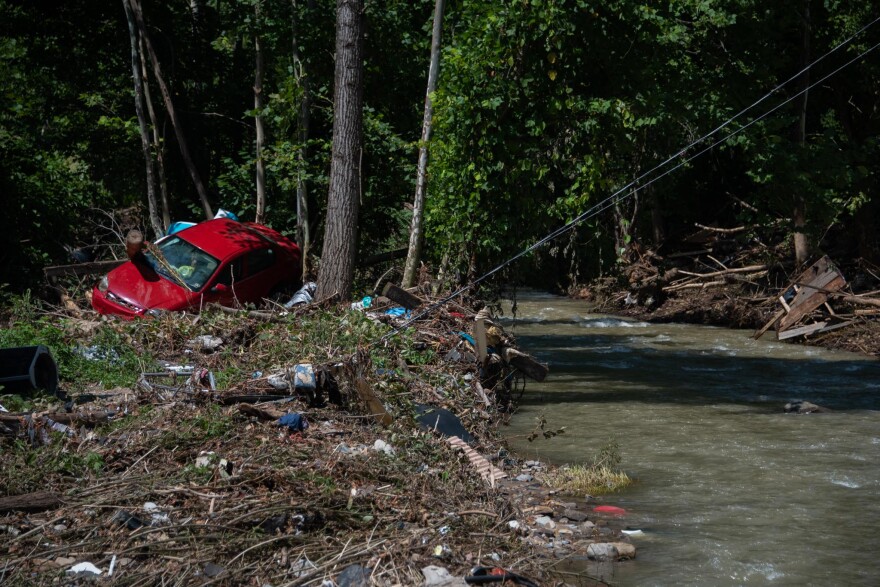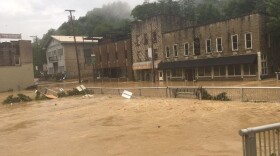Brian and Lesa Marcum pointed out sandy plots where homes used to be on Right Fork Buffalo Road a month after historic flooding hit eastern Kentucky. Water washed away cars, and clothing is still in tree branches sometimes 8 to 10 feet high.
“This is one reason I think the destruction up here didn’t get any attention…it’s so isolated,” Brian said. “You know it's not a town that’s easily accessible; it's in the middle of nowhere.”
Some side roads where they live in Owsley County aren’t paved, and the county hasn’t been able to repair all the damage yet. That makes it easy for floods to cut off already isolated mountain communities like Ricetown, Buckhorn and Buffalo from more populous small town centers.
Geography and distance present even more challenges for flood victims who’ve lost transportation and live far away from grocery stores, health clinics and schools.
The only grocery store in Owsley County is in Booneville, the county seat. There is no FEMA Disaster Recovery Center in Owsley County.
Small roads in rural communities
Since the flooding, private donations of cleaning supplies, furniture and meals have poured in from around the country. Two days after the flooding, Lesa Marcum organized meal deliveries for people in these isolated communities and drove up roads that prompted her to say a prayer.
She recently received hamburger and hot dog donations and will continue to deliver meals to people.
“If you're hungry, that's a bad feeling,” Marcum said. “I've worked in the school — if a kid’s hungry, they can't focus — so if an adult's hungry, it's about the same. And I feel like if they get one hot meal a day, then they can make it to the next day.”
In Buckhorn, a gymnasium serves as a distribution center. Marlene Stokely runs the center and said it’s been open every day since July 30th.
“And there's been days that we've been out of things like toilet paper and paper towels, cleaning supplies, but then churches and other schools bring more things in for us,” Stokely said.
Accessing medical care
Shortly after the rain stopped, Stokely trudged through deep mud to help her niece reach a hospital.
“She was 30 weeks pregnant, and she was having contractions,” Stokely said. “So I helped her and her 2-year-old daughter and her 3-year-old son back out through the mud.”
Stokely’s niece reached an emergency room, and medical staff successfully stopped her contractions.
Medical care can be hard to access, especially in Owsley and Knott counties, which do not have hospitals.
Tiffany Miller is the outreach coordinator at the University of Kentucky North Fork Valley Community Health Center in Hazard and said it’s been hard reaching patients who’ve lost their phones and vehicles. The flood completely destroyed a UK clinic in Hindman.
“We've had to, you know, go out on ATVs. And find these patients, because we know that a lot of our patients at the Hindman clinic are elderly,” Miller said.
Hindman is in Knott County where the average life expectancy is 72. That’s lower than the U.S. average of 78. In Owsley, it drops to age 69, and in Perry County it’s 68. Eastern Kentucky counties have high rates of cancer, smoking and many communities don’t have access to transportation.
“Here health care accessibility is a struggle, even when we're not in a natural disaster,” Miller said. “Getting people transportation to here, there are a few companies, not like you would find in the larger city.”
Clinic staff are used to delivering medical care. They run a mobile health clinic and a mobile dental unit for kids that serves Perry and surrounding counties. But recently, the clinic has adapted the dental unit to provide more care like tetanus shots and hepatitis A vaccines.
The clinic staff also brings patients basic supplies, too.
“So, …we'll stop by those distribution centers, get them their food box, get them their personal hygiene box, or we have it here at the clinic, and we'll get that for them and take their medication,” Miller said.
Buckhorn also lost its only school, so now students face longer bus rides to get to school in Hazard for the rest of the school year. Stokely said that’s been tough on kids.
“They already ride a bus 30 minutes to get to Buckhorn, and then they're going to have to ride another 45 minutes to get on to Hazard to where they relocated them.”
Federal and state aid
Many residents haven’t seen any FEMA inspectors in their communities, but Virgie Hacker of Ricetown met with one.
She said about two feet of water made it inside her home. She recently received a letter from FEMA asking for more information about her appeal, but she never filed one.
“So I have no idea,” Hacker said. “The inspector that come to the house wouldn’t go across the creek. She wouldn’t go across the bridge, which, that’s fine.”
Her house is only accessible by walking over a swinging bridge or driving through the shallow part of a nearby creek.
Hacker says she’s received $500 in emergency FEMA aid for things like groceries and moving expenses. She’s still waiting to find out if she’ll get funding for her home; it's now overtaken by mold, she said.
According to recent FEMA data analyzed by the Ohio Valley Resource, the median award for flood victims is $2,200.
Lesa Marcum has assisted with FEMA applications and appeals for years. Owsley County has had at least one federally declared flooding or severe storm disaster since 2018. The flooding in late July makes two this year alone.
Both Marcum and Hacker want to know where the state-run flood relief funds will go.
During a press conference on Aug. 31, Gov. Andy Beshear said that of the $8.5 million raised, $390,000 has been used to pay for 39 funerals.
Anyone who qualifies for FEMA assistance will also receive an additional $500 from the Team Eastern Kentucky Flood Relief Fund, Beshear said. He added that the state is working with FEMA to get people this money, and they do not need to apply.
Beshear said he hopes to have another announcement about how more funds will be distributed soon.





